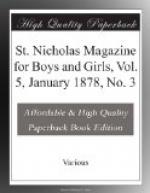A HEMLOCK PILLOW.
It is rather late in the year to make these pillows, but you can try them for next Christmas. They must be prepared for beforehand by gathering and drying a quantity of the needles of the hemlock, the fine ones from the ends of the young shrubs being the best. Make a large square bag of cotton, stuff it full of the needles, and inclose it in an outer case of soft thick silk or woolen stuff. The one from which we take our description had “Reve du foret” embroidered on it in dull yellow floss, and we don’t believe any one could help dreaming of the forest who laid a cheek on the pillow and smelled the mingled spice and sweetness of its aromatic contents.
SACHETS FOR LINEN-CLOSETS.
If you have any old-fashioned lavender growing in your garden, you can easily make a delightful sachet for mamma to lay among her sheets and pillow-cases in the linen-closet, by cutting a square bag of tarletane or Swiss muslin, made as tastefully as you please, and stuffing it full of the flowers. Another delightful scent is the mellilotte, or sweet clover, which grows wild in many parts of the country, and has, when dried, a fragrance like that of the tonquin-bean, only more delicate.
TISSUE-PAPER MATS.
[Illustration: A TISSUE-PAPER MAT.]
We like to be able to tell you about these mats, for they cost almost nothing at all, and are so simple that any little boy or girl can make them. All the material needed for them is three sheets of tissue-paper,—a light shade, a medium shade, and a dark shade, or, if you like, they can also be made of one solid color, but are not quite so pretty then. Cut a piece of each color nine inches square, fold it across, and then across again, so as to form a small square, and then fold from point to point. Lay on it a pattern, like the first diagram on next page, and cut the tissue paper according to the lines of the pattern. Opening the paper, you will find it a circle, with the edge pointed in scallops. Now take a common hair-pin, bend its points over that they may not tear the paper, slip it in turn over each point, as shown in the diagram, and draw it down, crinkling the paper into a sort of double scallop. (The second diagram on next page will explain this process.) Treat your three rounds in this way, lay them over each other like a pile of plates, stick a small pin in the middle to hold them, set a goblet upon them, and gently arrange the crinkled edges about its base, so as to give a full ruffled effect, like the petals of a dahlia, although less stiff and regular. These mats are exceedingly pretty.
[Illustration: DIAGRAM FOR PAPER MAT, SHOWING MODE OF FOLDING AND SHAPING.]
[Illustration: DIAGRAM SHOWING THE MANNER OF CRIMPING EACH SCALLOP OF THE PAPER MAT OVER A HAIR-PIN.]




